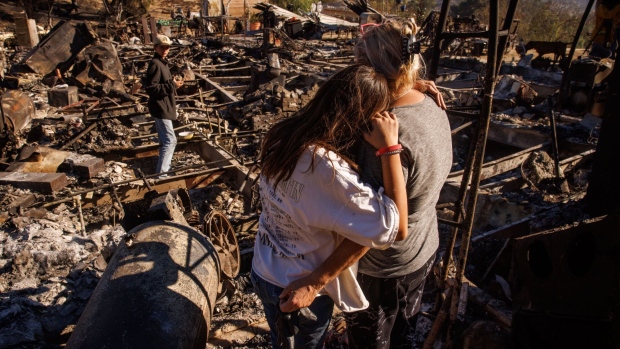Apr 27, 2024
Wildfires Pose Hidden Threat to Mortgage Lenders and Investors
, Bloomberg News

(Bloomberg) -- Above and beyond the obvious damage, wildfires levied a hidden cost on the finance industry: Mortgage lenders and investors lost more than $30 billion between 2020 and 2022, due to both accelerated defaults and prepayments following disastrous blazes.
Researchers from the University of Southern California, Rutgers and Concordia University studied $1.7 trillion of originations and more than 300,000 mortgages from 2000 to 2021. Within a year following a wildfire, they found, the likelihood of homeowners failing to make their payments increases by 1%. At the same time, borrowers are 4% more likely to pay off their loans early.
Either way, wildfire risk negatively impacts cash flows for mortgages, said Amine Ouazad, an associate professor of finance and economics at Rutgers and a co-author of the paper, published in March. It will be “a major source of risk in the next 10 years.”
The finance industry is hustling to understand the consequences of global warming, including more frequent storms, floods and droughts. Banks concerned about potential loan losses and impaired balance sheets have hired weather experts and catastrophe modelers to help estimate the potential portfolio impact of severe weather events.
Read more: Climate Change’s ‘Physical Risks’ Are Catching Up With Banks
In areas prone to wildfires, mortgages have gotten more expensive as lenders seek to offset the elevated risks of default and prepayment. The researchers found that a wildfire in the previous year increases interest rates for new loans by 5 basis points.
While small, the difference suggests that banks and investors are adjusting their pricing to account for the impact of extreme weather events, a departure from earlier assumptions that the risks would primarily be absorbed by insurers, Ouazad said.
“What we’ve observed is that the risk cannot be only contained within the insurance industry,” he said. “It is also spilling over into the mortgage industry.”
Mortgage-backed securities are also beginning to reflect that risk. For investors, the paper introduces metrics to assess diversification of wildfire risk, as a way to determine which bonds are more or less likely to be affected.
©2024 Bloomberg L.P.






